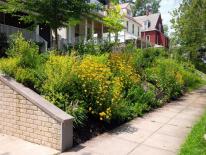
BayScaping
BayScaping is a landscaping practice that replaces grass with plants native to the Chesapeake Bay region. Native plants have deeper root systems that absorb more stormwater, reduce erosion, increase infiltration, and are more drought resistant than turf grass or ornamental species. BayScaping also provides beneficial habitat for pollinators like butterflies and honey bees.
BayScaping is a low-cost alternative to traditional landscaping.
How to BayScape
BayScaping is practical nearly anywhere in your yard but is preferred in sloped or eroded areas where dirt, bare soil, and/or invasive plants could be replaced by native plants that stabilize slopes and absorb more stormwater. BayScaping is designed to individual site characteristics, factoring in topography, soils, drainage patterns, and sun exposure. There are many readily available resources to assist you in finding native species to the Chesapeake Region to plant.
Benefits of BayScaping to the Homeowner
BayScaping requires less maintenance and money than a traditional grass lawn, and each BayScape can be unique in its aesthetic beauty. Specifically, BayScaping:
- Minimizes the need for mowing, pruning, irrigation and fertilization
- Costs typically half or as little as one-fifth the cost of conventional landscapes
- Can be creative and fun, designed with plants of your choice
Benefits of BayScaping to the District
The District is promoting BayScaping because it improves the health of local streams and waterways by absorbing more stormwater than a conventional landscape. Native plants used for BayScaping:
- Are more adapted to local climate conditions than exotic non-native species, resulting in less need (and cost) for herbicides, fertilizers, pesticides, or soil conditioning
- Help to remove pollutant sediments and heavy metals (i.e. cadmium and lead) from ground water
- Stabilize soils and prevent erosion
- Support local wildlife such as beneficial pollinators, songbirds, and butterflies by providing food (nectar and seed) and habitat.
Want to BayScape your yard? RiverSmart Homes can help.
DOEE's RiverSmart Homes program offers incentives to homeowners interested in installing BayScaping on their properties and reducing stormwater pollution. Existing beds that have plant material cannot be recommended for BayScaping; 120 square feet minimum of soil, turf, grass, or lawn must be replaced with native plants. BayScaping is generally only recommended for slopes that show erosion.
BayScaping Maintenance
BayScape projects need to be cared for, especially during the first two years. The RiverSmart Maintenance Assistance Program (RSMAP) assists property owners with the maintenance of their installed RiverSmart rain gardens and BayScapes.
The program offers free advice from the RSMAP team in three simple steps:
- First, submit a question through this link your maintenance questions. Please provide as much detail as possible regarding the issue with which you would like help, and include the original plant installation plan if you have it.
- Second, a RSMAP team member will respond to your inquiry within 3 business days. For more complex issues, we may have additional questions for you or ask for photos to assist in finding a solution.
- Third, after your issue has been resolved we will ask for feedback about RSMAP through an online survey. Your experience and opinions are critical to helping us improve the program and sustain funding.
For additional maintenance assistance, contact our providers, follow the simple steps below, review the attached documents or contact - [email protected] / (443) 449-8230.
- Water plants regularly if there has not been a significant recent rainfall
- Regularly weed, prune and mulch the garden
- Remove trash or other debris from the BayScaping

